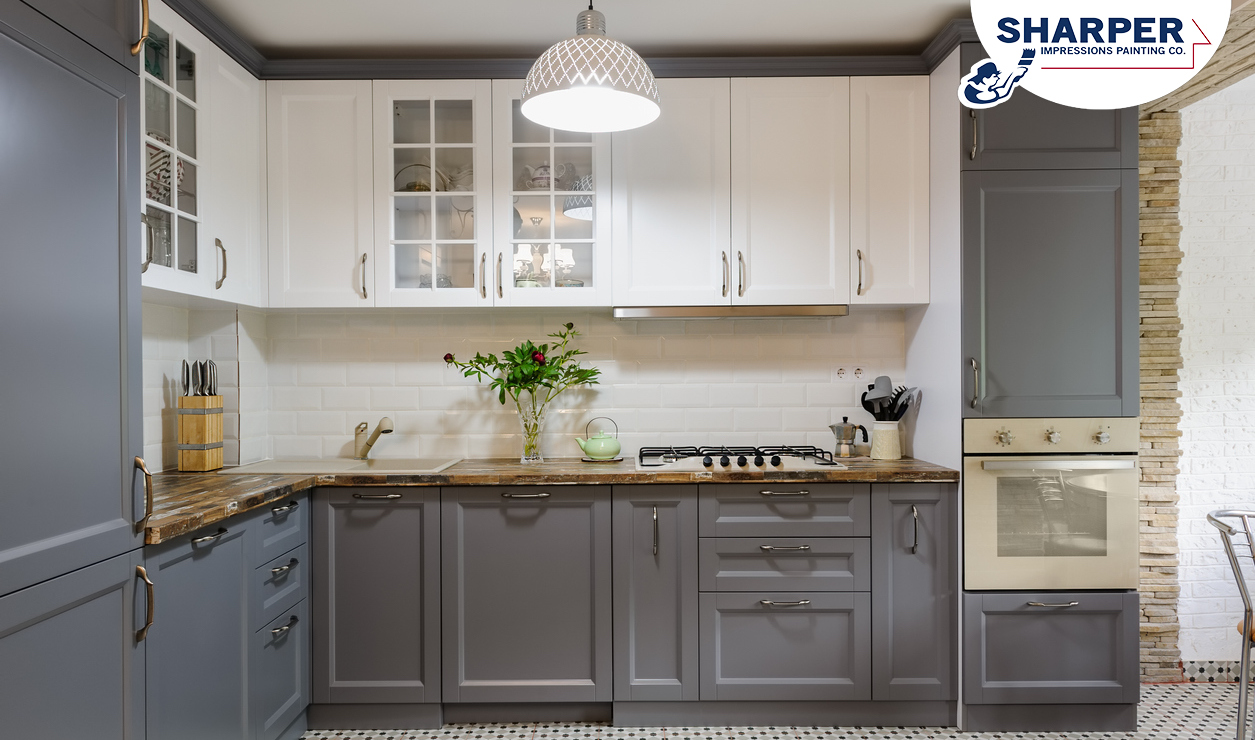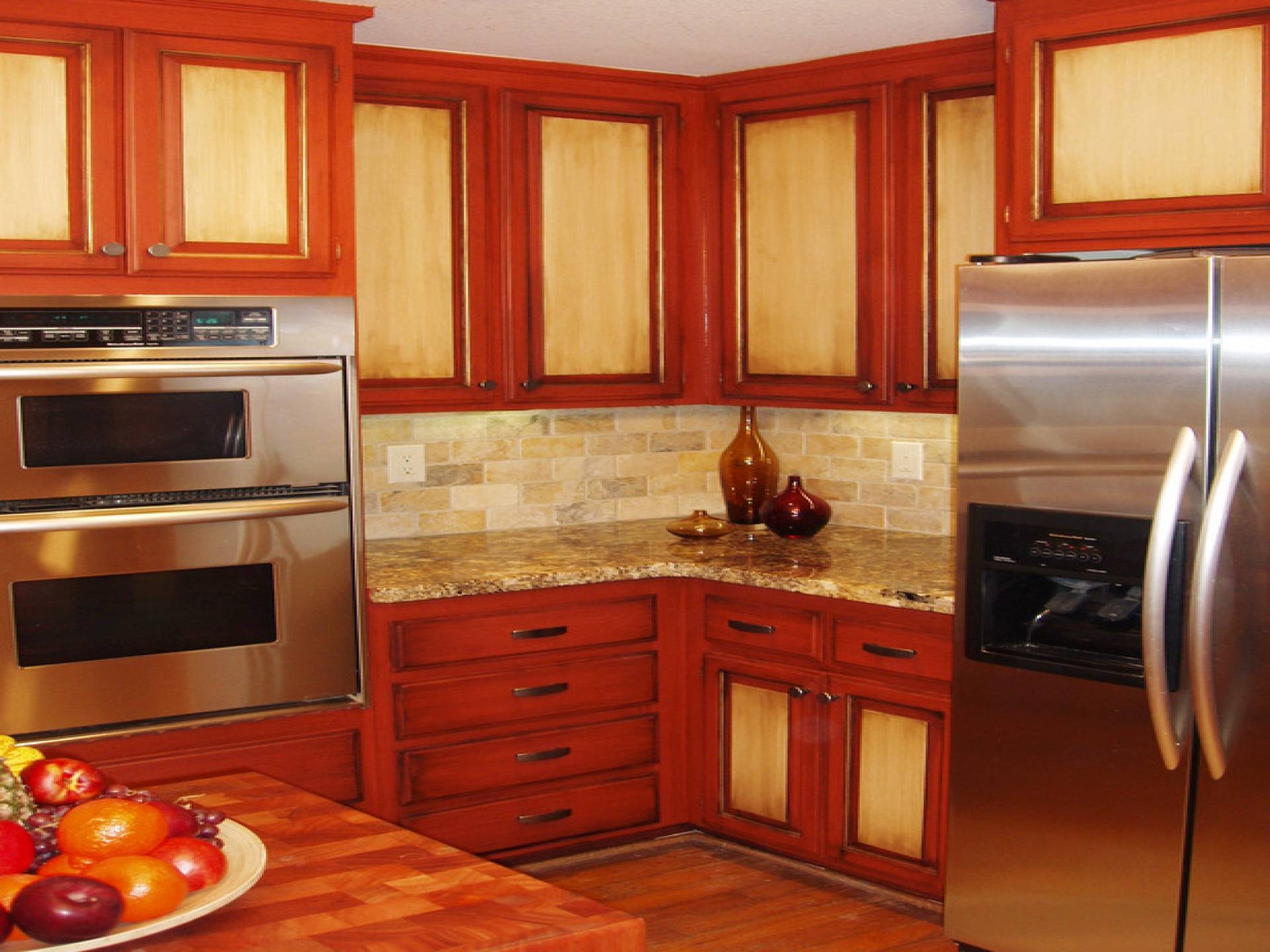Two-Tone Cabinet Styles and Trends

Two-tone cabinets have emerged as a popular trend in kitchen and bathroom design, offering a unique blend of style and functionality. This approach allows homeowners to create a visually captivating space that reflects their personal preferences.
Popular Two-Tone Cabinet Combinations
Two-tone cabinets offer a wide range of possibilities for creating visually appealing and functional kitchens and bathrooms. Here are some of the most popular combinations:
- White Upper Cabinets with Dark Lower Cabinets: This classic combination provides a sense of spaciousness and elegance. The white upper cabinets create a sense of airiness, while the dark lower cabinets add a touch of sophistication and grounding.
- Gray Upper Cabinets with White Lower Cabinets: This combination offers a modern and clean aesthetic. The gray upper cabinets provide a subtle contrast against the white lower cabinets, creating a visually balanced space.
- Wood Upper Cabinets with White Lower Cabinets: This combination blends the warmth of wood with the crispness of white. The wood upper cabinets add a touch of natural beauty, while the white lower cabinets provide a sense of brightness and airiness.
- Dark Upper Cabinets with Light Lower Cabinets: This combination creates a dramatic and sophisticated look. The dark upper cabinets add a touch of mystery and depth, while the light lower cabinets provide a sense of balance and lightness.
Factors Influencing the Choice of Two-Tone Cabinets
The decision to use two-tone cabinets in kitchen and bathroom designs is influenced by several factors, including:
- Personal Style: Two-tone cabinets allow homeowners to express their personal style and create a space that reflects their unique tastes.
- Room Size and Layout: Two-tone cabinets can be used to create the illusion of space or to highlight specific features in a room. For instance, using lighter colors on upper cabinets can make a small kitchen appear larger, while using darker colors on lower cabinets can draw attention to the countertop and appliances.
- Lighting Conditions: The amount of natural light in a room can influence the choice of cabinet colors. Lighter colors tend to reflect more light, making a room appear brighter, while darker colors can absorb light, creating a more intimate atmosphere.
- Existing Decor: The existing decor in a room can also influence the choice of two-tone cabinets. For example, if the walls are painted in a neutral color, using two-tone cabinets with bold colors can add a pop of personality to the space.
Examples of Two-Tone Cabinet Styles
- Modern Two-Tone Cabinets: Modern two-tone cabinets often feature sleek, minimalist designs with clean lines and geometric shapes. Popular color combinations include white and gray, black and white, or a combination of bold colors with metallic accents.
- Traditional Two-Tone Cabinets: Traditional two-tone cabinets often feature classic designs with ornate details and warm color palettes. Popular color combinations include white and wood, cream and brown, or a combination of neutral colors with subtle accents.
- Contemporary Two-Tone Cabinets: Contemporary two-tone cabinets often feature a blend of modern and traditional elements, with a focus on functionality and clean lines. Popular color combinations include white and dark gray, light gray and navy blue, or a combination of neutral colors with pops of color.
Practical Considerations for Two-Tone Cabinets: Two Tone Painted Cabinets

The decision to use two-tone cabinets in your kitchen or bathroom is a significant one. It allows for a unique and personalized look, but it also presents some practical considerations that must be weighed. The advantages and disadvantages of this design choice, as well as the impact of different countertop materials, should be carefully considered.
Choosing Paint Colors and Finishes
Selecting the right paint colors and finishes is crucial for creating a cohesive and aesthetically pleasing two-tone kitchen. The following are some important factors to consider:
- Color Harmony: Choose colors that complement each other and create a harmonious overall aesthetic. Consider using a color wheel to guide your choices. A popular approach is to select colors from the same color family, such as shades of blue or green, or to use contrasting colors, such as black and white.
- Light and Dark Contrast: Using a combination of light and dark colors can add depth and dimension to the space. A darker lower cabinet paired with lighter upper cabinets can create a sense of openness and height, while a lighter lower cabinet paired with darker upper cabinets can make the space feel more intimate.
- Finish: The finish of the paint can significantly impact the overall look of the cabinets. Matte finishes provide a more traditional and understated look, while gloss finishes create a more modern and polished appearance. Semi-gloss finishes offer a balance between the two.
- Room Size: The size of the room should be considered when choosing paint colors. In smaller spaces, lighter colors can make the room feel more spacious. In larger rooms, darker colors can add warmth and intimacy.
Impact of Countertop Materials
The countertop material you choose can significantly impact the overall aesthetic of two-tone cabinets. Here are some points to consider:
- Color Contrast: The countertop should contrast with the cabinet colors to create visual interest. For example, a light countertop can be paired with dark cabinets, and vice versa.
- Material Texture: The texture of the countertop material can also play a role in the overall look. A smooth countertop can complement sleek, modern cabinets, while a textured countertop can add warmth and rustic charm to traditional cabinets.
- Maintenance: Different countertop materials require different levels of maintenance. For example, granite countertops are very durable but require regular sealing. Laminate countertops are less expensive and easier to maintain but may not be as durable.
Design Tips and Inspiration for Two-Tone Cabinets

Two-tone cabinets are a fantastic way to add visual interest and personality to your kitchen. The right combination of colors can create a unique and stylish space that reflects your personal taste. Here are some design tips and inspiration to help you get started.
Kitchen Layout Considerations
The layout of your kitchen can significantly influence how two-tone cabinets are showcased. Here are some layout ideas to consider:
- Island with Contrasting Colors: A popular approach is to use a contrasting color for the island cabinets, creating a focal point and visually separating the island from the perimeter cabinets. For example, you could have white perimeter cabinets and a dark gray island.
- Vertical Split: This involves dividing the upper and lower cabinets with a different color. This approach creates a sense of height and emphasizes the verticality of the cabinets. Consider using a lighter color for the upper cabinets and a darker color for the lower cabinets.
- Horizontal Split: This technique involves using different colors for the cabinets on either side of the kitchen. For instance, you could have white cabinets on one side and blue cabinets on the other. This creates a sense of visual separation and defines different zones within the kitchen.
Mood Board Ideas, Two tone painted cabinets
A mood board can help you visualize different two-tone cabinet combinations and their potential impact on the overall design of your kitchen. Here are some mood board ideas to inspire you:
- Modern Minimalist: White upper cabinets paired with a dark gray or black lower cabinets create a sleek and contemporary look. This combination is complemented by stainless steel appliances and minimalist décor.
- Rustic Farmhouse: White or cream upper cabinets with a warm wood lower cabinets create a cozy and inviting atmosphere. This combination is enhanced by rustic décor, such as wooden beams, farmhouse sinks, and natural textures.
- Coastal Chic: Light blue upper cabinets paired with white lower cabinets evoke a serene and breezy vibe. This combination is accentuated by natural elements, such as driftwood, seashells, and blue and white patterned textiles.
- Bold and Dramatic: A combination of deep blue upper cabinets with a vibrant red lower cabinets creates a striking and attention-grabbing statement. This combination is best suited for larger kitchens with plenty of natural light.
Lighting Techniques
Proper lighting can significantly enhance the visual appeal of two-tone cabinets. Here are some lighting techniques to consider:
- Under-Cabinet Lighting: Under-cabinet lighting is essential for illuminating countertops and showcasing the details of the cabinet doors. It also creates a warm and inviting atmosphere.
- Pendant Lights: Pendant lights can be used to highlight the island or specific areas of the kitchen. They can also add a touch of style and sophistication to the space.
- Recessed Lighting: Recessed lighting provides general illumination and helps to create a balanced and evenly lit space.
- Accent Lighting: Accent lighting can be used to highlight specific features, such as a display cabinet or a piece of artwork.
Two tone painted cabinets – Two-tone painted cabinets can add a touch of visual interest to a room, much like the strategic placement of a bedroom ceiling fan in Canada can create a sense of airflow and comfort. Just as the fan’s blades circulate air, the contrasting colors in the cabinets can guide the eye, creating a dynamic and engaging space.
Whether you choose bold colors or subtle shades, two-tone cabinets can be a clever way to enhance the overall design of your home.
Two-tone painted cabinets offer a striking visual contrast, playing with the interplay of light and shadow. While they create a modern, almost architectural feel, sometimes a touch of warmth is desired. For this, consider pairing them with a natural wood bedroom dresser.
The organic texture and subtle grain of the wood provide a calming counterpoint to the sharp lines of the painted cabinets, creating a balanced and inviting atmosphere in your space.
